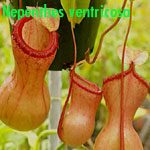Pitcher plants, or Nepenthes, are amongst the most bizarre plants in the world. There are around 90 recognised species and most grow in moist, humid areas where they receive year-round rainfall. Many can be found in Borneo, Sumatra and the Philippines, growing in heavily leached soils along with a variety of ferns and some orchids. It was once thought that pitcher plants were only for the dedicated enthusiast and had to be grown in heated glasshouses, but specialist plant collector and author, David Banks, says that some varieties are very easy to grow.
No need to fertilise!
Pitcher plants are carnivorous. They grow in very nutrient poor soils, so they catch their own food. The pitchers, which are modified extensions of the leaves, are brightly coloured. Insects are attracted by the colour and the scent of nectar on the underside of the lid. They soon lose their footing on the slippery surface and fall into the pitcher. Once inside there is no escape. They quickly sink and drown in the viscous fluid, which is a mixture of water and digestive juices secreted by the pitcher. Upper or aerial pitchers trap flying insects such as flies and mosquitoes, while ground-hugging traps are designed to catch larger prey, such as cockroaches, beetles and even mice!
Growing pitcher plants
Pitcher plants are best grown in a free-draining but moisture retentive mixture, with added medium-grade orchid bark and chopped sphagnum moss. In hanging pots or baskets the preferred medium is pure sphagnum moss, which holds many times its own weight in water. Water pitcher plants well. Never let them dry out, and mist them throughout the warmer months. They need high humidity and bright, indirect light for pitcher production. Pitcher plants grow well in ferneries, under pergolas or trees, or with an orchid collection. Fertiliser is not needed.
Species or hybrids of species such as N. truncata, N. mirabilis and N. ampullaria are best grown in tropical climates or in heated glasshouses in cooler climates, as they don’t tolerate temperatures lower than 15



